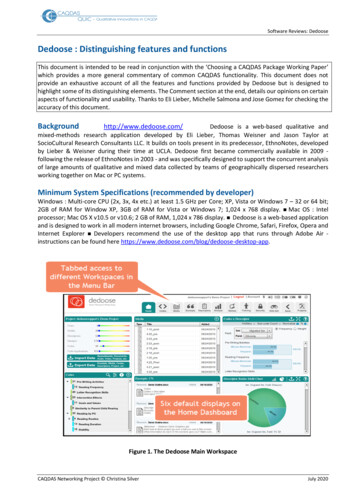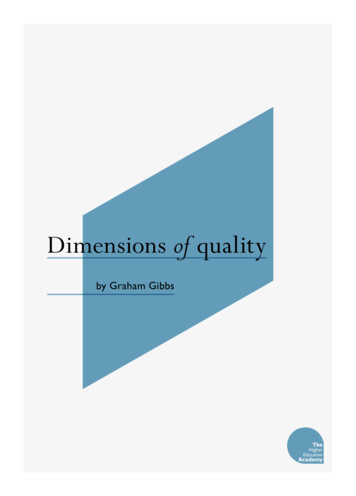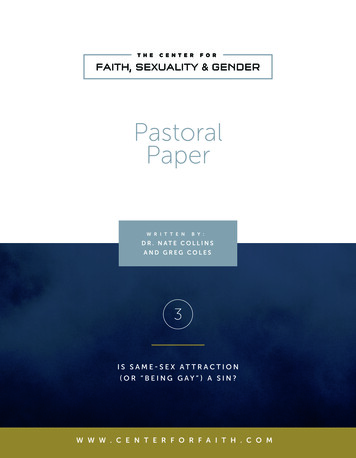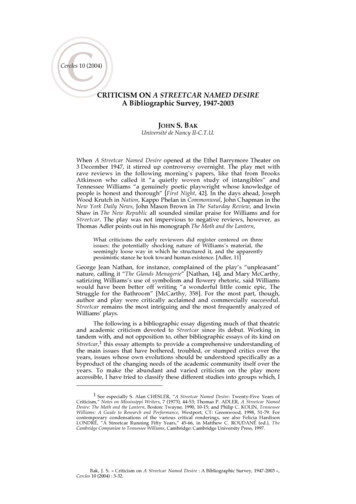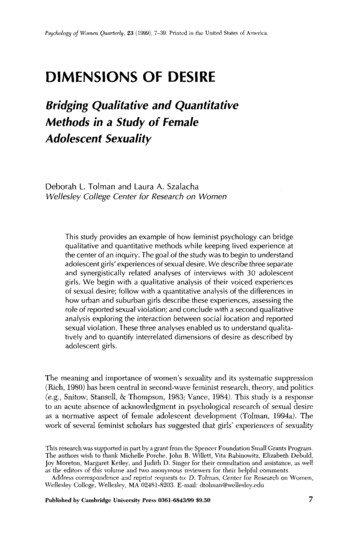
Transcription
Psychology of Wo?nen Quan edy, 23 (1999), 7-39, Printed in the United States of AmrricnDIMENSIONS OF DESIREBridging Qualitative and QuantitativeMethods in a Study of FemaleAdolescent SexualityDeborah L. Tolman and Laura A. SzalachaWellesley College Center for Research on WomenThis study provides an example of how feminist psychology can bridgequalitative and quantitative methods while keeping lived experience atthe center of an inquiry. The goal of the study was to begin to understandadolescent girls’ experiences of sexual desire. We describe three separateand synergistically related analyses of interviews with 30 adolescentgirls. We begin with a qualitative analysis of their voiced experiencesof sexual desire; follow with a quantitative analysis of the differences inhow urban and suburban girls describe these experiences, assessing therole of reported sexual violation; and conclude with a second qualitativeanalysis exploring the interaction between social location and reportedsexual violation. These three analyses enabled us to understand qualitatively and to quantify interrelated dimensions of desire as described byadolescent girls.The meaning and importance of women’s sexuality and its systematic suppression(Rich, 1980) has been central in second-wave feminist research, theory, and politics(e.g., Snitow, Stansell, 6s Thompson, 1983; Vance, 1984). This study is a responseto an acute absence of acknowledgment in psychological research of sexual desireas a normative aspect of female adolescent development (Tolman, 1994a). Thework of several feminist scholars has suggested that girls’ experiences of sexualityThis research was supported in part by a grant from the Spencer Foundation Siriall Grants Program.The authors wish to thank Michelle Porche, John B. WiViUett, Vita Rabinowitz, Elizabeth Debold,Joy Moreton, Margaret Keiley, and Judith D. Singer for their consultation and assistmnce, as wellas the editors of this voluine and two anonymous reviewers lor theii- helpful comments.Address correspondence arid reprint requests to: D. Tolrnan, Center for Research on Women,Wellesley College, Wellesley, MA 02481-8203. E-mail: dtoI iinn wellesley.eduPublished by Cambridge University Press 0361-6843199 9.507
8TOLMANAND SZALACHAand sexual desire in particular are a significant, albeit neglected, force in girls’development (e.g., Cowie & Lees, 1987; Nava, 1987; Thompson, 1984, 1995) andas such are potentially crucial in girls’ developing a sense of entitlement andempowerment (Fine, 1988;Tolman, 1994b). Feminist social psychologist MichelleFine identified a “missingdiscourse of desire” in adults’ discussions of girls’ sexuality(Fine, 1988). Her research suggested that girls do know and speak of desire, despiteanxious or even well-meaning denial of female adolescent sexual desire on the partof the adults in their lives. Fine’s research raised the question of how girls speakabout and experience their own sexual feelings. The goal of this study was to beginto understand the dimensions of the experience of sexual desire for adolescentgirls.There are several intertwining reasons that psychology, even feminist psychology,has not made significant inroads into the question of adolescent girls’ sexual feelings.Feminist scholars have theorized how patriarchal suppression of female sexualityis a key aspect of women’s oppression (i.e., Rich, 1980; Vance, 1984). Despiteextensive inquiry into female adolescent sexual behavior (e.g., Delameter & MacCorquodde, 1979; Lees, 1986; Levinson, 1986; Scott-Jones & Turner, 1988) anda history of theorizing sexuality development (e.g., Benjamin, 1988; Freud, 1905;Jordan, 1987),there have been no studies that include the question of girls’ sexualdesire (Thompson, 1984; Tolman, 1994a). Buried within an ostensibly objectivestance is the historical denial and denigration of female adolescent sexuality (Tolman, 1996). These studies also belie the politics of adolescent pregnancy as theytrickle down into the research world. Conducted primarily by sociologists anddemographers, such studies offer a limited conception of girls’ sexuality. They ifocuson whether or not and when girls have had sexual intercourse and whether or notthey have used effective measures of contraception and seek to identify trends inthe outcomes of girls’ choices about heterosexual intercourse. The agenda of suchstudies has not been to understand or support the development of healthy sexualityamong girls (Tolman, in press). To achieve the goals of marking behavioral trendsand distinguishing between “good and “bad” groups of girls, these studies almostexclusively rely on survey method. This methodology has framed and limited forgirls what the pertinent questions and possible answers are about what is importantin the development of their sexuality,’The current study represents a different research agenda by locating a que.stionabout girls’ sexuality development within a query about girls’ healthy psychologicaldevelopment. Moving away from a focus on sexual intercourse, sexual behavior,sexual attitudes, or even sexual outcomes, our research question is phenomenological: How do girls describe their sexual experiences and sexual feelings and in .whatways do they speak about their own bodies in telling their stories of desire? Thistheoretica1 shift ushers in a movement away from survey methods toward methodsthat provide research participants with opportunities to convey the meanings theymake of their experiences. It also requires the explicit use of a feminist methodological approach.Qualitative, phenomenological methods that enable understanding of people’sexperiences (Denzin & Lincoln, 1994; Packer & Addison, 1989) and the feministperspective necessary to inform inquiry into an aspect of female experience thatis systematically denigrated and denied in a patriarchal society (Irigaray, 1981;Omolade, 1983; Rich, 1980) do not yet enjoy wide respect within psychology
Dimensions of Desire9(Morowski, 1994). Even within feminist psychology, the question ofwhat constitutesfeminist methods continues to be intensely debated and unresolved (Crawford &Maracek, 1989; Fine, 1992; Maracek, 1989; Riger, 1992). This debate has oftenrevolved around two approaches to understanding feminist methodology and therole of methods in feminist transformation of psychology. One approach to feministmethods is to work within psychology’s methodological traditions, using conventional quantitative methods to answer research questions driven by feminist theory.Such research is more easily accepted by the discipline and thus has been thoughtby some to have more potential to transform it (Lykes & Stewart, 1986). Thesecond approach holds that feminist methods are subject centered and thereforenecessarily qualitative, disruptive of the tradition of objective experimental andsurvey methods in the field (Fine & Gordon, 1989). Such methods are aimed atgenerating knowledge about women’s lives previously not produced by psychologists, thus transforming the information as well as the practices that constitutepsychological knowledge and its production.These two approaches have consistently been positioned in opposition to oneanother and framed as a choice in practice for feminist researchers. These verydifferent perspectives on feminist methodology have contributed to the debateabout the very concept of feminist methods itself. By demonstrating how bothqualitative and quantitative methods can be used synergistically in a way thatbalances and integrates the concerns and demands of both feminist perspectiveson methods, we hope that the methodological approach to learning about adolescentgirls’ experiences of sexual desire described in this article may serve as a contributionto defusing and reconfiguring this often divisive debate within feminist psychology.The disagreements about methodology within feminist psychology reflect largerconcerns within psychology and within the social sciences as a whole about whatconstitutes good research in the wake of poststructuralism and the ensuing postmodem debates about research paradigms (e.g., Cook & Reichardt, 1979; Sechrest &Sidani, 1995; Shadish, 1995;Weedon, 1987).In offering an approach that integratesqualitative and quantitative methods in a feminist research project, we begin bycontextualizing the feminist debates within these larger issues. The debate onthe relative value, appropriateness, and possible integration of quantitative andqualitative research paradigms has been a part of research in psychology’s landscapefor almost two decades (Cook & Reichardt, 1979; Healy & Sewart, 1991;Jayaratne &Stewart, 1991). Quantitative and qualitative approaches are often understood asseparate paradigms of research, with radically differing assumptions. requirements,and procedures that are rooted in completely different epistemologies. One positionof the philosophical debate contends that the integration of quantitative and qualitative paradigms is impossible, as they represent irreconcilable worldviews (e.g.,Guba & Lincoln, 1989; Mishler, 1986). The opposite position, maintained on bothphilosophic and pragmatic grounds, is that not only can the two paradigms becombined at the hands-on level of research practice, at the sociological level ofmethodological assumptions, and at the metaphysical level of metatheoretical assumptions, they should be so combined. because these concerns are superseded inimportance by political goals about how research findings should he used (Firestone,1993; Tashakkori & Teddlie, 1998).Finally, there are those who maintain that the point is not to accommodate orreconcile distinct paradigms but to recognize each as unique, historically situated
10TOLMANA N DSZALALHAforms of insight.’ Lee Schulman (1986) argued that each research paradigm isbound by the programs and departments that teach them. Each research paradigmhas grown “out of a particular perspective, a bias of either convention or discipline,necessarily illuminating some part of the field of teaching while ignoring the rest”and that “the danger for any field of social science or educational research liles inits potential corruption (or worse, trivialization) by a single paradigmatic view”(pp. 2-3). Rather than force a dichotomous choice, Kidder and Fine (1987) havesuggested that researchers both avoid “homogenizing research methods and cultures,” and strive to be “bicultural” (p. 57). Sktric (1990) suggested that the goalof researchers should be to understand both quantitative and qualitative paradigms,to learn to speak to them and through them, and to recognize that each are ‘waysof seeing that simultaneously reveal and conceal.”Unfortunately, the ongoing philosophical debate and discussion, although aliveat conferences, on faculties, and in some journals, are rarely incorporated explicitlyinto actual research. At the same time, the substantive combination of qualitativeand quantitative methods has gone forward, despite or in lieu of this epistemologicalunrest (Shadish, 1995).Guided mostly by pragmatic perspectives such as those ofPatton (1990a) and Greene (1994), the qualitativelquantitative “joint venture” hasbecome a feature in many dsciplines, inost notably in public health (e.g.,Carlson,1996; Keenan, 1996), program evaluation (e.g., House, 1994; Patton, l9Wa, 1990b;Keichardt & Rallis, 1994), education (e.g., Goldfarb, 1995) and, to some extent,in psychology (e.g., Debats, 1995; Gladue, 1991; Hines, 1993; Way, Stauber, &Nakkula, 1994). Indeed, some have claimed that “methodological pluralism .is anabsolutely necessary strategy in the face of ovenvhelrning cognitive limitations andbiases inherent in human mental processing and responding” (Sechrest & Sitlani,1995, p. 80). The challenge of grappling with increasingly complex social problems,particularly those that confront activist and applied psychologies like feminist psychology, demands that we investigate further the hidden potential in combiningquantitative and qualitative research methods.The combination of methods has appeared in several recognizable forms. A“pseudo-combination” is a study conducted wholly under one rubric, with the othertype of method serving simply as a support or illustration. The “logic-in-use”(Kaplan, 1964) of the study largely ignores one of the two approaches. Quantit,ativestudies of this sort often have some illuminating portraits to “liven up the numhers”or to add richness. Qualitative studies may provide some “quasi-statistics”(Becker,1986), which serve to add the legitimacy that numbers have traditionally coinmanded.There are, however, studies in which both approaches are genuinely and equitablyused. One possibility is a concurrent approach (Whitbourne & Powers, 1994). Inthis type of study, there is a peaceful coexistence or parallel process wherein twostudies are conducted simultaneously, though each is whole and separate from theother. The chief difficulty lies in the integration of the findings of two very diffe.rent,almost separate studies. Kidder and Fine (1987) cautioned that dfferent methodswithin different paradigms are not simply addressing the same questions differently.Instead, they are addressing dfferent questions, revealing different levels of activity,and leading to different knowledge, interpretations, and expIanations. Such differences raise thorny questions of how to square or interpret coritradictoiy findings.A second possibility for an integrated design is a sequential approach, in which
11Dimensions of Desirea study is conducted in phases, using one method for one part of the study andthen another method for another part. Most often this has taken the form of anexploratory qualitative study, which gives rise to the formulation of an instrumentand then a confirmatory quantitative study. It can also be, however, that one wouldconduct a quantitative survey in order to provide profiles to frame questions andsampling for a qualitative phase. It is important to note that in this approach,neither the qualitative nor the quantitative method is superior and neither sequenceis preferred (Maxwell, 1996). A third possibility is what Patton (1990b) suggestedas “methodological mixes,”in which one combines various methods simultaneously.This “technical eclecticism”requires a pragmatic point of view; methods, regardlessof whether they originate in a qualitative or quantitative paradigm, are irrelevantto the question of what makes research viable. Finally, there is also the possibilityof a wholly “integrated approach,” wherein one combines both quantitative andqualitative approaches throughout the entire process from the formation of researchquestions, to decisions about sampling, to data collection and analyses. A realadvantage in this option is the possibility of a methodological dialogue-an ongoing,dialectically informative interaction at each point of the research.The study we report here does not [it neatly into any of these specific strategiesfor combining qualitative and quantitative methods; rather, the blend of qualitativeand quantitative methods at which we have arrived is a kind of sequential integration.What distinguishes this approach is that it is explicitly feminist in nature; whatdrove our decisions was a feminist organizing principle of listening to and takingwomen’s voices seriously (Andersen, Armitage, Jack, & Wittner, 1990; Belenky,Clinchy, Goldberger, & Tarule, 1986: Gilligan, 1982; Oakley, 1981), particularlyin data collection and data reduction, ;is well as in data analysis and interpretation.Working with a single database, a set of intensive, semi-structured interviews with30 adolescent girls attending public schools in urban and suburban settings, weposed and answered a series of questicins grounded in feminist theory and researchon female adolescent sexuality. Our method of data collection is anchored in aqualitative epistemology and methodology, and we use multiple methods of dataanalysis, including careful interpretations of narrative data and also more reductive,statistical methods of analysis, to answer an array of related feminist questionsabout female adolescent experiences (of sexual desire. By choosing the method ofdata analysis that enabled us to answer each emerging question, the result hasbeen an eclectic merging of both approaches to feminist methodology, producinga kind of feminist eclecticism that has at its heart the perspectives and experiencesof these young women.METHODParticipantsThe design of this study was grounded in the possibility that both qualitative andquantitative analyses would be performed. ToIman chose a random sample size of30,” balancing concerns that the sample be large enough to conduct statisticalanalyses, while at the same time producing a manageable amount of rich narrativedata.’ Tolman collected data from eleventh grade girls, who ranged in age from
12TOLMANAND SZALACHA15-19, at an urban public high school ( n 15) and a suburban public high school( n 15).6The sample thus represents an age group in which sexual activity is partof the social landscape and includes girls who are subject to various sexual stereotypes: Urban girls (often girls of color) are considered to be overly sexual, whereassuburban girls are thought of as asexual (Tolman, 1996).The design was meant toenable a challenge of such stereotypes of girls and to open the question of whatnormal sexuality is for all adolescent girls. In the urban school sample there wereseven Black, three Latina, and five White girls.‘ In the suburban school, we ,spokewith 14 White girls and 1 Latina girl. The suburban girls are from Protestant,Catholic, and Jewish families, whereas the urban girls are from Protestant andCatholic backgrounds. One of the girls is a self-described lesbian, and two describedesire for both boys and girls.In this analysis, we focus on the differences between and similarities among girlswho live in an urban and a suburban social location. Tolman did not collect specificdata on socioeconomic status (SES) for several reasons. As we will discuss in thetext that follows, because Tolman was asking girls to speak about something thatis essentially unspeakable, she made careful choices about what she did and didnot ask so as to enhance the development of trust. Rather than collect conventionalsocioeconomic data on participants’ parental, educational, and occupational background, which in the context of these interviews could have been experienced bythe girls as alienating, she asked them to tell her in their own words about theirfamilies and social contexts. Based on their descriptions of their parents’ work livesand their daily experiences with crime, housing, and need for social services intheir neighborhoods and communities, Tolman concluded that although there wassome variation within each group, the urban girls were all from poor and workingclass families, and the suburban girls were all living in middle- and upper-middleclass families. In addition to girls’ descriptions, differences such as levels in obviouspoverty, explicit violence, community and educational resources, neighborhoodstability and general well-being were discemable from observation, substantkatingthe girls’ reports of their environments. We conclude that the urbadsuburbandifference in this case is a reasonable reflection of gross class differences in termsof the experiences and meanings associated with these girls’ daily lives. Becausethese class designations are not precise, we understand and interpret our data interms of differences in social locations rather than class per se, with these twodistinct social locations offering a meaningful interpretive context for understandinghow girls speak about, make meaning of, and experience their sexuality. In otheranalyses from this study, Tolman has integrated cultural characteristics in interpreting these data (e.g., Tolman, 1994a, 1996).ProcedureA key component of this feminist inquiry is the method of data collection. Groundedin an explicitly feminist method of data collection (Brown & Gilligan, 1992, Taylor,Gilligan, & Sullivan, 1996; Way, 1995), Tolman invited in-depth narrative anddescriptive data from girls on their thoughts about and subjective experiences of
Dimensions of Desire13sexuality, including sexual desire, sexual pleasure, feeling sexy, and sexual fantasies,during private, one-on-one, semi-structured clinical interviews that lasted from 45minutes to 2 hours. One of the primary tools of oppression of women is themaintenance of silence about their experiences and perspectives (Lorde, 1984;Rich, 1980). Acknowledging the possibility of female adolescent sexual agency,desire, pleasure, and fantasies through the act of asking about these realms ofexperience renders this approach a feminist research method. This method departsfrom a survey design by creating an opportunity for girls to put into words and toname their experience in and questions about a realm of their lives that remainsunspoken in the larger culture. Thus, as a form of data collection, it enables us tolearn from girls what might otherwise remain an unhown perspective on this partof their lives.Each interview included a standard set of questions; follow-up questions guidedby a feminist relational approach to psychological inquiry were asked in directresponse to the specific contours of each interviewee’s particular experiences(Brown & Gilligan, 1992;Way, 1995).The consent of participants and their parents(for girls who were under 18) was obtained prior to the interview. All interviewswere tape-recorded and transcribed. Confidentiality and anonymity in reportingwere ensured. No girl disclosed an experience of current sexual abuse or violence.The girls who disclosed past sexual abuse and dating violence were referred, withtheir permission, into appropriate therapeutic situations when they so wished.This study as a whole has three iterations that are organized by three separate andsynergisticallyrelated research questions, which emerged sequentiallyin response tothe findings generated by pursuing the previous research question. These threequestions demanded three different methods of analysis of our interview data.Together, the results emerging from these three analyses shed a multilayered lighton adolescent girls’ experiences of sexual desire.D A T A ANALYSIS A N D RESULTS: QUESTION 1Question 1 : How Do Girls Describe TheirExperiences of Sexual Desire?The aim of this component of the study was to understand how the girls in thissample experience and describe their own sexual desire and to learn about theplace of their bodies in this experience. The focus on the embodied nature ofsexual desire was grounded in a view that psychological health and vitality, selfknowledge, and lived relationships are anchored in the body (Gilligan, Brown, &Rogers, 1989; Young, 1992) and that the meanings we make of our bodily experiences are socially constructed (Rubin, 1985). The findings from this componenthave been previously reported (Debold, Tolman, & Brown, 1996; Tolman, 1994a,19941 ,1996; Tolman fx Higgins, 1996), but in order to present the interlockingquality of the evolving methodological choices we made in this study, we willdescribe the methods and results of this analysis.
14TOLMANAND SZALACHAData AnalysisThe data were analyzed by combining two methods of qualitative analysis. Thisapproach to data analysis was dso used in part in answering Question 3 of thisstudy, so we provide a complete description of our approach at this juncture.Tolman identified one narrative in which the girls told a story about an experienceof sexual desire to analyze in depth using a method of narrative analysis IdledThe Listening Guide, a feminist interpretive method (Brown, Debold, Gilligan, &Tappan, 1991; Brown, Tappan, Gilligan, Miller, & Argyris, 1989; Gilligan et d.,1989;Rogers & Gilligan, 1988).Acknowledgingthe multilayered nature of narrativesand of the psyche, the “polyphonic and complex” nature of voice and experience(Brown & Gilligan, 1992, p. 15)highlights how there is no single way to understandany given narrative. Therefore, each narrative is read or “listerxd to” several distincttimes; for each listening, the researcher focuses on or “listens for” a given aspectof the experience under study, underlining with a colored pencil the parts of thenarrative in which the identified “voice”is expressed. A voice is a way of speakingthat has an identifiable set of coherent features. Throughout this process, theresearcher continuously checks and records her own thoughts, emotional and embodied feelings, and reactions as part of the data analysis. This method is groundedin a feminist standpoint (Nielsen, 1990), acknowledging that patriarchal culturesilences and obscures women’s experiences by providing the listener with an organized way to respond to the coded or indirect language of girls and women, especiallyfor topics such as sexuality about which girls and women are not supposed to speak.This psychological approach to data analysis is accomplished in part because thismethod is explicitly relational, in that the researcher brings her self-knowledgeintothe process of listening by using clinical methods of empathy to contriltute to herunderstanding of what a girl is saying.This relational practice increases the listener’sability to avoid bias or “voicing over” a girl’s story with her own reactions, much likea skilled therapist can use countertransference to inform rather than ovenvhelrn psychotherapy (Tohnan, 1992).In this analysis, Tolman listened for four voices associated with girls’ experienceof sex ialdesire: A voice of the self, an erotic voice, a voice of the body, and avoice of response to one’s own desire. In listening for self, a standard voice of TheListening Guide, the reader attends to the interviewee as the narrator of the storyby following the verbal markers for self, such as “I” or “me.” Listening for the selfis an efficient way of laying bare in what relationship the narrator places herselfto her experience. The listening for self reveals agency and absence of agency, aswell as the narrator’s experience of herself as a subject and as an object, in thenarrative context. Tolman then identified two desire voices, an erotic voice and avoice of responses to one’s own desire, which are specific to analyzing what girlssay about sexuality, using a grounded-theory approach (Straws, 1987). Listeningfor an erotic voice tracks the ways in which girls speak about how sexual desirefelt and what it was like for them, such as the intensity or specific quality of‘theirsexual feelings. Listening for a voice of response to their sexual desire tracks howgirls desciibe their thoughts and behavior in reaction to feeIing their own sexualdesire. Finally, listening for the voice of the body tracks how girls describ)e theexplicitly embodied character of their desire and sexuality experiences.The result of these sequential listening and underlinings is a visual map of thedifferent layers of a given experience in a narrative. The way that each voice maps
Dimensions of Desire15in relation to the other voices is observed and recorded. Then the underlined partsof the narrative are transferred onto worksheets, so that interpretations can bemade for what the narrator is saying in close proximity to her actual words. Thistracking system enables the researcher to create a trail of evidence (Brown etal., 1989) for the interpretation that is developed. The result is a voice-centeredinterpretation of girls’ narratives of sexual desire, which presents one way to understand these stories, a way that privileges feminist questions of agency, body, andrelationship. By providing ample text in reporting results of such analyses (e.g.,Brown & Gilligan, 1992; Tolman, 1994a, 1994b), the researcher enables others todevelop alternative interpretations informed by different theoretical perspectives.The second form of data analysis used was the construction of a conceptually clustered matrix for identitjang patterns within and between groups (Miles & Huberman,1984). Using the voice of self, the voice of the body, the erotic voice, and the voice ofresponse as the frame for organizing the interpretations of these narrative data, Tolman incorporated the difference of urban and suburban social locations into the construction of this matrix. This way of organizingthe qualitative data revealed how thesetwo groups of girls voiced similar experiences of sexual desire and how their experiences had different qualities. This method also highlights individual variation withineach group of girls, so that exceptions to patterns can be examined and understoodas part of the diversity of experience for each group of girls.ResultsAs Tolman has reported, about two thirds of the entire sample said they felt desire;the remainder said they were confused about whether or not they felt desire, orthat they did not feel desire. There were several patterns in the data that werethe same for both urban and suburban girls. In the stories of all of the girls whosaid they felt desire, an erotic voice was audible and characterized by the power,intensity, and urgency of their feeling. All of these girls described their experienceof sexual desire in physical terms, defying the common conception of girls’ desireas relational rather than embodied by expressing an audible “voice of the body.”At the same time, there was an overall pattern for both the urban and suburbangirls who voiced desire in these ways to question their entitlement to their ownsexual feelings and to express doubt about the possibility of acting directly on theirown desire and then being considered good or normal.Although an erotic voice and a voice of the body sounded similar for urban andsuburban girls, differences emerged in how they described their responses to theirsexual desire-a kind of “main effect” of social location. One way to characterizethis differe
8 TOLMAN AND SZALACHA and sexual desire in particular are a significant, albeit neglected, force in girls' development (e.g., Cowie & Lees, 1987; Nava, 1987; Thompson, 1984, 1995) and as such are potentially crucial in girls' developing a sense of entitlement and
